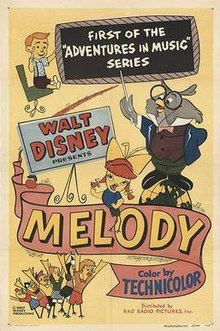The Revolutionary Debut of ‘Melody’ on May 28th, 1953
On May 28th, 1953, the world witnessed a groundbreaking moment in animation history with the premiere of ‘Melody,’ the first animated 3-D cartoon in Technicolor. This innovative short film was part of Walt Disney’s ‘Adventures in Music’ series, a collection designed to educate audiences about musical concepts in a captivating manner. The release of ‘Melody’ marked a significant leap forward in animation technology and storytelling, embodying Disney’s relentless pursuit of innovation and excellence.
Walt Disney’s vision for ‘Melody’ extended beyond entertainment. The film aimed to educate viewers about melody, an essential component of music, through engaging animation and storytelling. This educational purpose was a hallmark of Disney’s work, reflecting his commitment to creating content that was both informative and enjoyable. The ‘Adventures in Music’ series, with ‘Melody’ as its flagship, exemplified this blend of education and entertainment.
The premiere of ‘Melody’ was a highly anticipated event, garnering attention from contemporary newspapers and promotional materials. These historical documents highlight the excitement and curiosity surrounding the film’s release. Audiences were eager to experience the novelty of 3-D animation, a technological marvel at the time. Reviews and articles from the period underscore the film’s impact, noting its vibrant colors, immersive 3-D effects, and the engaging way it presented musical education.
Walt Disney’s role in producing ‘Melody’ was pivotal. His dedication to pushing the boundaries of animation is evident in the film’s innovative use of 3-D technology and Technicolor. Disney’s broader contributions to the animation industry are well-documented, with ‘Melody’ standing as a testament to his visionary approach. The film not only entertained and educated but also set a new standard for animated storytelling.
For those interested in further exploring the historical context and significance of ‘Melody,’ reputable sources such as the official Disney archives and historical film databases provide valuable insights. These resources offer a deeper understanding of the film’s place in animation history and its lasting impact on audiences and creators alike. The premiere of ‘Melody’ on May 28th, 1953, remains a landmark moment, celebrating the fusion of artistry, technology, and education in animation.
Technological Innovations and the Legacy of ‘Melody’
The premiere of the first animated 3-D cartoon “Melody” on May 28, 1953, marked a significant milestone in the history of animation. One of the most striking aspects of “Melody” was the innovative use of 3-D technology combined with vibrant Technicolor visuals. This pioneering effort brought a new dimension to animated storytelling, literally and figuratively.
Developing and implementing 3-D technology in “Melody” required overcoming numerous technical challenges. Animators and technicians at Disney Studios had to innovate new methods for creating depth and perspective, ensuring the 3-D effects were both immersive and visually coherent. The use of Technicolor further enhanced the visual experience, providing a vivid and dynamic color palette that brought the animated characters and backgrounds to life.
These technological advancements did not come without their difficulties. The process of synchronizing 3-D effects with Technicolor animation was complex and labor-intensive. However, the breakthroughs achieved in “Melody” set a new standard for animated films. The film’s success demonstrated the potential of 3-D animation and color technology, inspiring future projects and pushing the boundaries of what was possible in the medium.
Comparatively, other animated works of the time primarily relied on traditional 2-D animation techniques. While these films were often beautifully crafted, they lacked the immersive quality that “Melody” provided. The unique combination of 3-D technology and Technicolor in “Melody” offered audiences an unprecedented viewing experience, setting it apart from its contemporaries.
The legacy of “Melody” extends beyond its immediate impact. It paved the way for subsequent advancements in 3-D animation and color technology, influencing both the animation industry and cinematic storytelling. Future animated films, such as those produced by Pixar and DreamWorks, owe a debt to the pioneering efforts of the “Melody” team. For further reading on the technological innovations in animation, consider exploring scholarly articles on animation technology and interviews with Disney animators.

